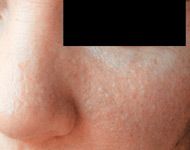- Case-Based Roundtable
- General Dermatology
- Eczema
- Chronic Hand Eczema
- Alopecia
- Aesthetics
- Vitiligo
- COVID-19
- Actinic Keratosis
- Precision Medicine and Biologics
- Rare Disease
- Wound Care
- Rosacea
- Psoriasis
- Psoriatic Arthritis
- Atopic Dermatitis
- Melasma
- NP and PA
- Skin Cancer
- Hidradenitis Suppurativa
- Drug Watch
- Pigmentary Disorders
- Acne
- Pediatric Dermatology
- Practice Management
- Prurigo Nodularis
- Buy-and-Bill
Article
Multiple facial papules? Consider Birt-Hogg-Dub?
Newport Beach, Calif. — When a patient presents with multiple facial papules, consider the rare but potentially fatal condition known as Birt-Hogg-Dub? syndrome, says Melvin W. Chiu, M.D., who spoke at the annual meeting of the Pacific Dermatologic Association.

The presence of multiple facial papules may call to mind other diagnoses, such as tuberous sclerosis or Cowden's syndrome. Often, however, the telltale sign of Birt-Hogg-Dubé, which can be associated with pulmonary disease and malignant renal tumors, is the presence of benign hair follicle tumors such as fibrofolliculomas or trichodiscomas, according to Dr. Chiu, dermatology resident with the David Geffen School of Medicine at University of California, Los Angeles.
While the exact prevalence is not known, Birt-Hogg-Dubé syndrome is considered a serious condition that is rarely suffered. It is an autosomal-dominant condition most often characterized by multiple fibrofolliculomas. Reports on patients with this disease have also described lung cysts, spontaneous pneumothoraces and renal cancers.
Dr. Chiu describes one case that had been referred to UCLA by an area physician. That particular patient, a 34-year-old woman, had multiple asymptomatic facial papules and a history of pneumothorax. In addition, family history revealed that several family members had similar facial papules.
"It seemed like it all fit very well with the diagnosis," Dr. Chiu says.
Histopathology of one of her facial papules was found to be consistent with a fibrofolliculoma. After that, the patient was sent for a kidney CT scan to be sure no renal tumors were present.
"Luckily, the CT scan was negative for any renal neoplasms," Dr. Chiu says. "The facial papules are benign and are of cosmetic concern, but the patient needs to be closely monitored for the development of a renal tumor."
On the skin, this syndrome usually manifests as small, skin-colored dome-shaped or pedunculated lesions of the face, though at least one case report describes small, elevated intraoral papules on mucosal surfaces, such as the buccal mucosa (Nadershahi NA et al., Oral Surg Oral Med Oral Pathol Oral Radiol Endod. 1997; 83: 496-500). Patients with the disease may begin to notice bumps appearing in the third decade of life.
While an isolated benign hair follicle tumor isn't usually a concern, multiple fibrofolliculomas should be "a little alarming" for the examining dermatologist, Dr. Chiu says.
Up to a quarter of Birt-Hogg-Dubé syndrome patients will have spontaneous pneumothorax, and perhaps 15 percent may develop kidney cancer. The condition has also been associated with colonic neoplasms, but some recent reports have cast doubt on the association. Researchers with the National Cancer Institute recently looked at nearly 100 patients and 112 unaffected family members; they found increased risk of renal tumors, but reported that colon cancer and polyps were "not related" to the condition (Zbar B et al., Cancer Epidemiol Biomarkers Prev. 2002; 11: 393-400).
Since the condition was first described in 1977, approximately 60 articles or case reports have been published in peer-reviewed journals. Researchers with the University of Pennsylvania recently published a comprehensive literature review and differential diagnosis for the syndrome (Vincent A et al. J Am Acad Dermatol. 2003 Oct;49(4):698-705).
Genetics studies have provided some insight into its cause. Researchers have discovered a mutation in a novel gene encoding a protein of unknown function called folliculin (Khoo SK et al., Oncogene. 2001; 20: 5239-5242).





